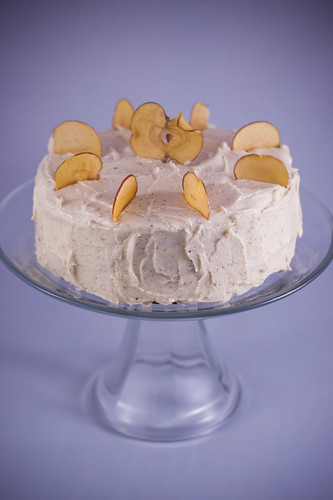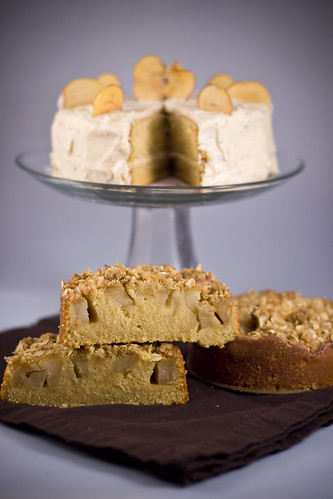
Dolores of Culinary Curiosity co-hosted this months challenge with Alex of Brownie and Blondie and Jenny of Foray into Food. The recipe was given to us by a fellow blogger Shuna Fish Lydon at Eggbeater
CARAMEL CAKE WITH CARAMELIZED BUTTER FROSTING
as published on Bay Area Bites
FOR THE CAKE:
10 Tablespoons unsalted butter at room temperature
1 1/4 Cups granulated sugar
1/2 teaspoon kosher salt
1/3 Cup Caramel Syrup (see recipe below)
2 eggs, at room temperature
splash vanilla extract
2 Cups all-purpose flour
1/2 teaspoon baking powder
1 cup milk, at room temperature
Preheat oven to 350F
Butter one tall (2 – 2.5 inch deep) 9-inch cake pan.
In the bowl of a stand mixer fitted with a paddle attachment, cream butter until smooth. Add sugar and salt, and cream the mixture until light and fluffy.
Slowly pour room temperature caramel syrup into bowl. Scrape down bowl and increase speed. Add eggs/vanilla extract a little at a time, mixing well after each addition. Scrape down bowl again, beat mixture until light and uniform.
Sift flour and baking powder.
Turn mixer to lowest speed, and add one third of the dry ingredients. When incorporated, add half of the milk, a little at a time. Add another third of the dry ingredients, then the other half of the milk and finish with the dry ingredients. {This is called the dry, wet, dry, wet, dry method in cake making. It is often employed when there is a high proportion of liquid in the batter.}
Take off mixer and by hand, use a spatula to do a few last folds, making sure batter is uniform. Turn batter into prepared cake pan.
Place cake pan on cookie sheet or 1/2 sheet pan. Set first timer for 30 minutes, rotate pan and set timer for another 15-20 minutes. Your own oven will set the pace. Bake until sides pull away from the pan and skewer inserted in middle comes out clean. Cool cake completely before icing it.
Cake will keep for three days outside of the refrigerator.
FOR THE CARAMEL SYRUP:
2 cups sugar
1/2 cup water
1 cup water (for "stopping" the caramelization process)
In a small stainless steel saucepan, with tall sides, mix water and sugar until mixture feels like wet sand. Brush down any stray sugar crystals with wet pastry brush. Turn on heat to highest flame. Cook until smoking slightly: dark amber.
When color is achieved, very carefully pour in one cup of water. Caramel will jump and sputter about! It is very dangerous, so have long sleeves on and be prepared to step back.
Whisk over medium heat until it has reduced slightly and feels sticky between two fingers. {Obviously wait for it to cool on a spoon before touching it.} ***
Note: For safety reasons, have ready a bowl of ice water to plunge your hands into if any caramel should land on your skin.
FOR THE CARAMELIZED BUTTER FROSTING:
12 tablespoons unsalted butter
1 pound confectioner’s sugar, sifted
4-6 tablespoons heavy cream
2 teaspoons vanilla extract
2-4 tablespoons caramel syrup
Kosher or sea salt to taste
Cook butter until brown. Pour through a fine meshed sieve into a heatproof bowl, set aside to cool.
Pour cooled brown butter into mixer bowl.
In a stand mixer fitted with a paddle or whisk attachment, add confectioner's sugar a little at a time. When mixture looks too chunky to take any more, add a bit of cream and or caramel syrup. Repeat until mixture looks smooth and all confectioner's sugar has been incorporated. Add salt to taste.
Note: Caramelized butter frosting will keep in fridge for up to a month. To smooth out from cold, microwave a bit, then mix with paddle attachment until smooth and light.
This is the variation I had mentioned up at the top. I took some of the leftover caramel syrup and mixed it with equal parts apple juice and added 1 tsp of mulling spices to the pan and gently poached some apple quarters until they were tender but still firm. Ideally these should sit in the poaching liquid overnight or at the very least allowed to sit in the poaching liquid until both the pears and liquid are completely cool. After that I put some cake batter into the pan (filled about 1/3 of the way up the pan) and then placed the apples on top and then sprinkled some strussel on top (optional). I made one cake without the strussel and worked out as well. With the fruit it no longer needed the frosting making it a little more casual and not quite as sweet. This cake was definitely a keeper and the frosting as well!

***I found that I may not have cooked the syrup down quite as far as I should have, I found that the bottom of my cake was a little dense and I have a feeling it may have been from a little too much liquid in the batter. When I was boiling my syrup I temped the syrup at 220 F and next time I would go up to 224 F and I think that would eliminate the problem. For those without a thermometer just follow the original directions using your fingers as your guide!











